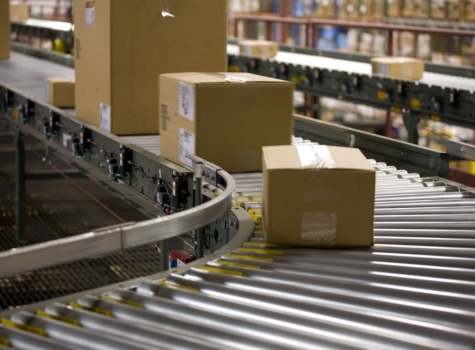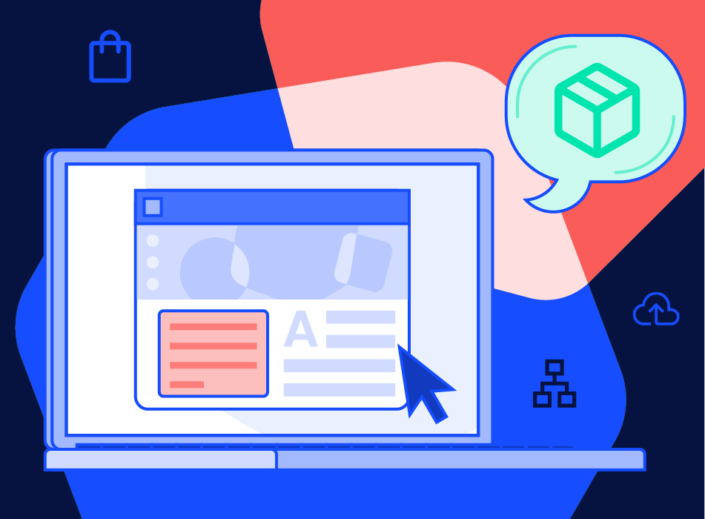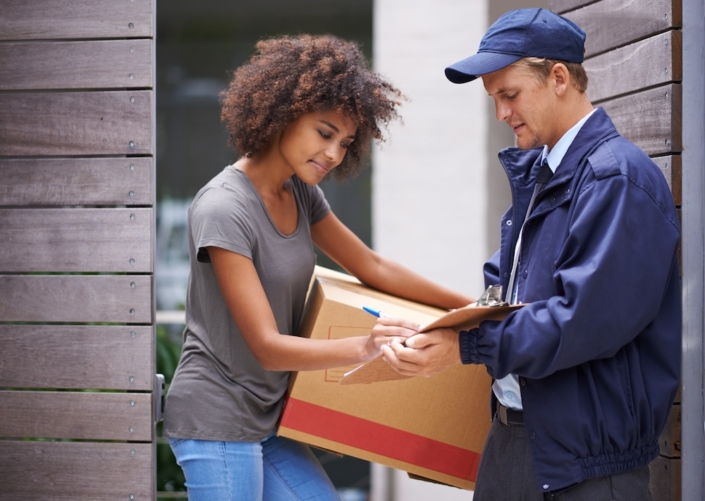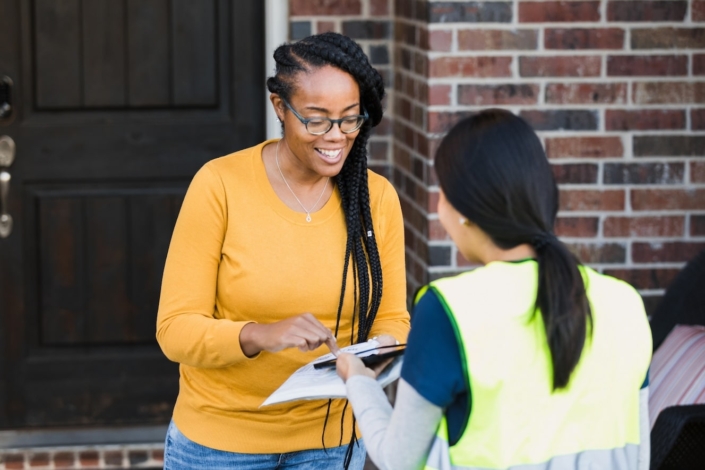Once you send packages off with the carrier, they move from one carrier facility to another until they reach their final destination. At these facilities, parcels are scanned, sorted, and sent to another facility or a customer’s home. It’s sort of like a layover on a long flight, where you may change planes, be delayed, or more.
In this article, we’ll talk more about how carrier facilities work and explain why it’s important for your business to understand what’s happening in them.
What is a carrier facility?
Carrier facilities are distribution centers (DCs) where carriers scan, sort, and sometimes store packages that will be delivered within a certain geographic region. FedEx, UPS, USPS, and even Amazon each operate their own facilities. After packages are dropped off at one of these DCs, they’re processed and sent to a different facility or the end customer.
As a business, it’s important to understand how carrier facilities work. After all, when you ship packages with carriers, you’re trusting them to complete each delivery safely and on time. If something goes amiss during shipping, it’s up to you to communicate with the carrier and customer to resolve the issue. Having a solid understanding of how carrier facilities operate will make this easier.
How carrier facilities work
Carrier facilities play a major part in the streamlined logistics network we have today, where packages travel across the country in a matter of days. By strategically placing these distribution centers, carriers significantly reduce transit times and make sure packages take the most efficient route to their final destination. For a clearer picture of how these centers work, read the step-by-step process below.
Step 1: Package intake
After a carrier picks up your shipments, they take them to a carrier facility. Facilities may be large or small, depending on the size of the geographic area they support and the number of packages passing through them each day.
Step 2: Sorting and scanning
Once the packages are in the facility, they’re scanned and sorted based on their destination or mode of travel, with the carrier’s system determining the most efficient route for each shipment. Some packages will be stored in the warehouse, in special storage conditions if applicable (cold storage, darkrooms). Others will continue their journey right away.
Step 3: Loading onto transport
After sorting, packages are loaded onto trucks or delivery vans that are heading to the right geographical area. Some shipments will be sent to their final destination, while others will head to another carrier facility.
Step 4: In-transit tracking
Each time a package reaches a new carrier facility, it’s scanned again. This allows you and your customers to receive real-time updates to monitor a package’s progress.
Step 5: Last-mile delivery and delivery confirmation
Eventually, each package is loaded onto a vehicle for last-mile delivery, the stage where it’s delivered to the recipient’s address. Once a package is delivered, the carrier system is updated to reflect the successful delivery. This triggers a notification to the customer that provides confirmation and a timestamp of when the package was delivered.
How long do packages stay at carrier facilities?
Normally, packages won’t stay at carrier facilities for more than one or two days. However, if the facility is overburdened with shipments or understaffed, they sometimes stay at the facility for several days.
Why does a package sit at a carrier facility?
Packages usually get stuck at carrier facilities when drivers or vehicles are in short supply, or when order volumes are higher than usual (as often happens during peak season). Unforeseen supply chain disruptions can also cause issues. For example, winter weather recently impacted one of FedEx’s largest facilities, which caused delays for many of the carrier’s service levels.
Addressing common customer questions
With package tracking, customers may receive notifications when their shipments arrive at or leave a facility. Unfortunately, they don’t always understand what these messages mean. Fortunately, you do! If a customer reaches out with a concern, you’ll know exactly how to respond.
What does it mean when it says a package has arrived at a carrier facility?
When a notification says a package has arrived at a carrier facility, it means the package has reached a carrier’s distribution center and will soon be embarking on the next leg of its journey.
What does it mean when it says a package has left the carrier facility?
When a notification says a package has left the carrier facility, it means the package has been loaded onto a truck or delivery vehicle and is on its way to another facility or the customer’s home.
Can you pick up packages from a carrier facility?
Neither you nor your customers are allowed to pick their packages up from a carrier facility. These distribution centers are industrial buildings, so they aren’t open to the public. However, you can offer alternative delivery options if a customer would rather pick up a package than have it dropped off at their home.
USPS, UPS, and FedEx all allow people to pick up their packages at a designated location, whether it be their own store or a secure access point.
USPS Hold for Pickup Service
The USPS Hold for Pickup Service allows customers to pick up their package from a nearby post office. The service only applies to certain items and shipping methods, including Commercial mailings of the following types:
- Priority Mail Express (excluding Priority Mail Express Military® Service and Priority Mail Express Open and Deposit®)
- Priority Mail
- USPS Ground Advantage
- Parcel Select Lightweight®
- Bound Printed Matter parcels
The recipient must show an ID when they pick up their package, and if it isn’t picked up within 15 days, USPS will return it to the sender.
UPS Store Alternate Delivery Program
The UPS Store Alternate Delivery Program allows businesses to securely send packages to customers. Packages are sent to one of UPS’s 5,000+ locations, and recipients must show an ID before collecting their package. You can also offer delivery to official UPS Access Points.
FedEx Hold at Location
FedEx Hold at Location lets you offer customers the option to pick up their packages from one of thousands of retail locations, including FedEx stores, Walgreens, Dollar General, and more. This service comes with an additional bonus—it eliminates the residential delivery fee FedEx usually charges.
Why package tracking matters
Carrier facilities are important parts of the shipping process, and one key role they play is facilitating package tracking. Each time a package is scanned at a carrier facility, customers receive an update on its location. In addition to giving them peace of mind, this data allows your business to more easily resolve issues associated with lost or damaged shipments.
Optimize processes
Tracking data gives you visibility into your shipping, allowing you to estimate how long deliveries will take, plan shipping schedules, and find areas of improvement.
Avoid lost, delayed, and damaged shipments
Tracking data reveals patterns about when items get lost or damaged. If you frequently notice issues with a specific carrier, you can show evidence when you discuss it with them. By proactively addressing carrier performance, you’ll minimize future package damage or loss.
By actively managing and resolving shipping issues, your business will uphold its reputation for reliable and timely delivery.
Provide a better customer experience
If a customer’s package gets lost, damaged, or delayed, they’ll probably feel frustrated and helpless. With the help of tracking information, you can step in to troubleshoot and resolve the issue. If you have shipping insurance or want to take advantage of a carrier’s declared value program, you’ll use tracking data as evidence during the claims process.
Even when deliveries go smoothly, tracking is a valuable part of the consumer experience. Customers appreciate being informed about the status of their orders. With accurate tracking information, they can plan to receive their packages, reducing the anxiety associated with uncertain delivery times.
Track every shipment with EasyPost
Knowing how a carrier facility works might not revolutionize your logistics, but it will help you better understand the delivery process from start to finish. This makes it easier to resolve shipping issues, communicate with carriers, and give customers peace of mind. The key to it all? Offering a seamless package tracking experience.
EasyPost provides real-time tracking solutions for small, medium-sized, and enterprise businesses. For smaller organizations, the Tracking API is an ideal solution to empower your business and increase customer satisfaction.
Enterprise-level organizations will benefit from EasyPost Enterprise, a powerful suite of solutions specially designed for high-volume shippers.




